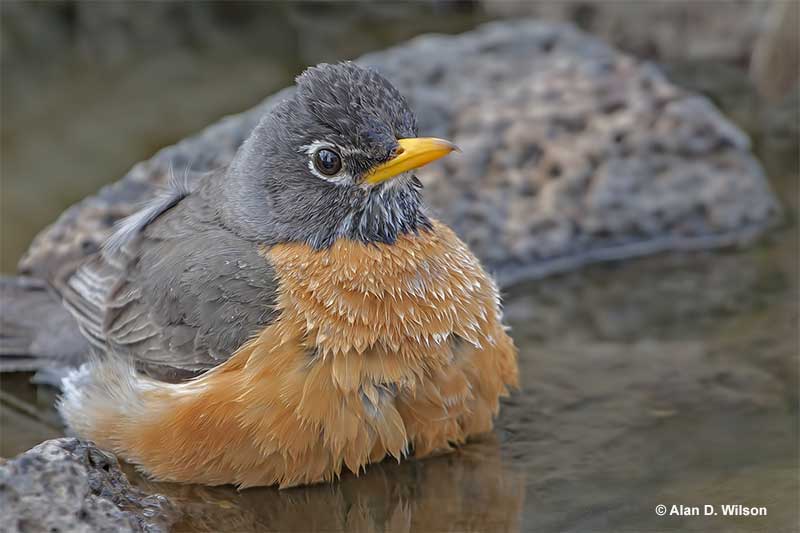
Connecticut is a small New England state with 5,543 square miles of woodlands, fields, wetlands, and coastal habitats. This northeastern state is also home to 5.6 million people and 451 species of birds!
One of the birds on the Connecticut bird list is the official state bird; the American Robin. This much appreciated gray thrush with brick-red underparts is heard and seen throughout Connecticut.
On this page
About
The American Robin (Turdus migratorius) became the state bird of Connecticut in 1943. In this year, the General Assembly decided to finally vote and declare this species the official state bird.
Like other states, during the 1920s, local chapters of Federated Women’s Clubs had carried out campaigns to select a state bird. However, in Connecticut, there wasn’t as big of a push to pick a state bird as some other places.
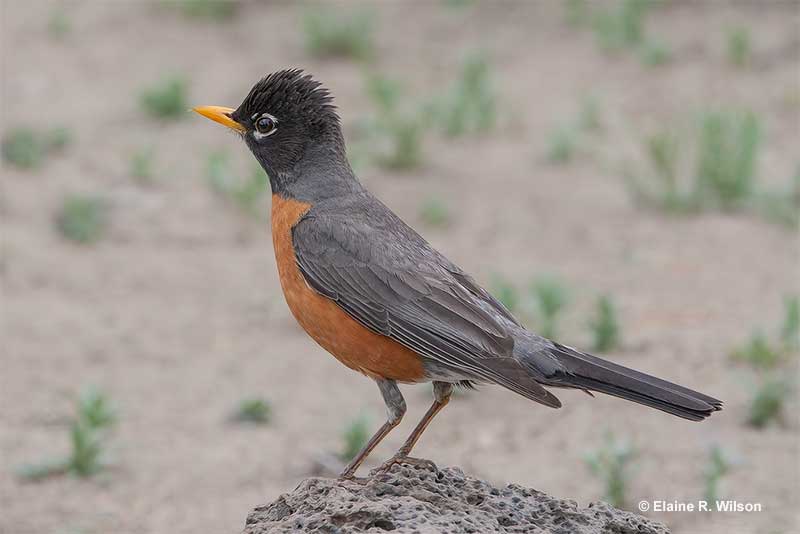
Unlike other states, they didn’t organize as many initiatives to vote for state birds or make the general populace as aware of the situation. Most of all, there was no organized vote for schoolchildren to choose a state bird.
In large part, for that reason, Connecticut picked an official state bird several years after most other states. At first, they talked about choosing the Ruby-crowned Kinglet. This small bird is cute, abundant in the state, and easy to see.
However, it just didn’t have as much common appeal as the American Robin. With that in mind, the Connecticut General Assembly settled on this common thrush species.
In Connecticut, American Robins are much appreciated and easily recognized birds. No matter where you go in the state, you are bound to see American Robins. Visit in spring and summer and you’ll also hear their pretty, whistled songs.
Fun Facts about American Robins
- American Robins are often viewed as the first sign of spring and are believed to migrate away for the winter. While they do sing during spring, most actually spend the winter in rural areas near their summer breeding grounds.
- This species is one of the most common birds in North America. Some biologists have estimated their population to number well over 350 million!
- Although they are named American Robins, this name stands for all of North America. American Robins are not just common in the United States, they inhabit most of Canada and Alaska during the breeding season and migrate to Mexico for winter. In the United States, they stay on their territory year-round.
- American Robins can become intoxicated. While they don’t drink beer, they do eat berries and other fruit. If they eat too much fermented fruit, they can get tipsy or even become unconscious.
- This species was named after a somewhat similar bird in Europe; the European Robin. However, these two birds are not related to each other. The American Robin is a type of thrush while the European Robin is a member of the “Old World Flycatcher” family.
- American Robins have adapted to urban surroundings by changing their songs. In cities and other urban situations, they sing at a higher frequency. Robins probably do this so other robins can hear their songs over the noise of the city. Abundant hard surfaces in cities might also affect their song acoustics.
- This species takes full advantage of the summer months by nesting two or three times. This is probably an adaptation to high mortality rates of young birds. Studies have shown that a low percentage of young American Robins reach one year of age.
- Connecticut is not the only one with this bird as the symbol of their state. Michigan and Wisconsin have the American Robin as their state bird too!
Identification
Part of the Turdidae family, American Robins are fair-sized songbirds with long legs. On average, these thrushes are 10 inches long, have a 17-inch wingspan, and weigh 2.7 ounces. Both sexes are similar in size but differ in some other ways.
Male American Robins have black heads with white markings on their throat and around their eyes. They have dark gray on their back and wings, and white on the corners of their blackish tail.
They also have a bit of black edging on the feathers of their longish wings, and brick-red chest feathers and flanks.
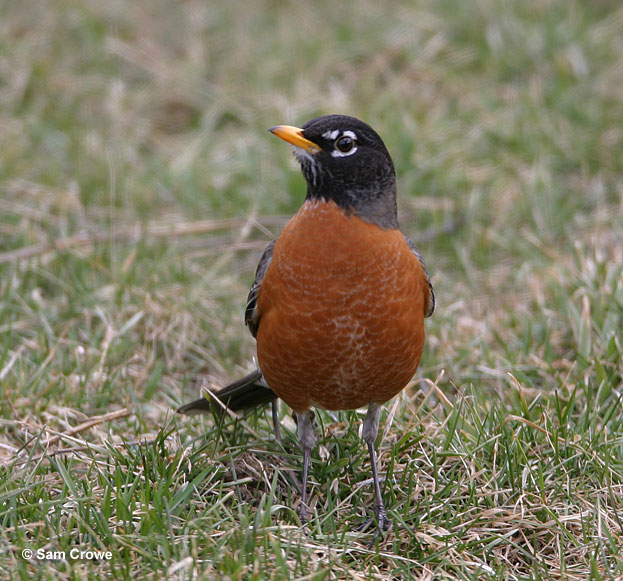
Female American Robins look like paler versions of male birds. Some look nearly the same, but most are noticeably paler. While they also have white bellies and undertails like male birds, females usually have more pumpkin-orange on their underparts.
Some are also so pale that they have white throats, show pale eyebrows, and have some pale edging on their wings.
Young American Robins resemble females but have dark spots on their underparts, and some white markings on their back.
What do American Robins eat?
The Connecticut state bird feeds on insects, earthworms, and various other small creatures. They also eat and fruit and berries. In general, during the summer months, this species eats a lot more bugs and worms. They switch to eating a lot of fruit during the fall and winter months.
This thrush forages for insects, worms, and other invertebrates on the ground. They stand in open, grassy areas like lawns and golf courses and stay alert for their prey.
When they spot a worm or other food item, the robin quickly hops over to grab it with its beak.
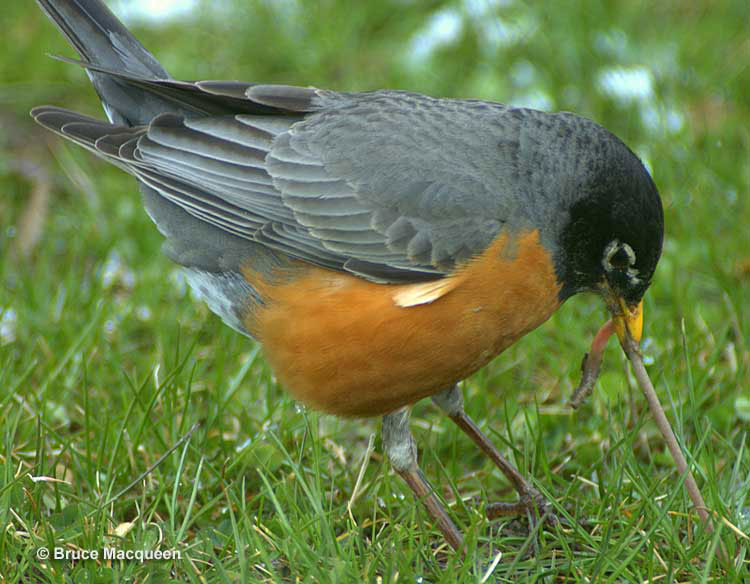
If the bird doesn’t notice anything, it moves forward to look for prey from another spot.
In winter, American Robins act very differently. Instead of foraging on the ground in pairs or on their own, they form flocks and feed on winter berries. Some of the more common plants that American Robins feed on include Juniper, Honeysuckle, Hawthorn, and Chokecherry. However, they can also eat various other fruits, including crabapples.
When a flock of robins discovers a fruiting tree, they quickly fly down to it and start feeding. They eat fruits by perching and picking the food with their beaks. These birds can also pick up fruit that falls to the ground.
Call
Both sexes of the American Robin make brief laughing sounds, and often make a loud, sharp call, “yink”. One of their vocalizations is several rapid, “yink” calls, and they make a high-pitched “seeyut” sound in flight.
Male robins have a pleasant and melodious song. They repeat five to seven, short, flute-like or whistled phrases. Their songs can differ but usually sound like, “plurit plurah keewah kiwit pluruh”.
Behavior
In towns and parks, American Robins often become used to people. These birds are easy to watch and are frequently seen singing from a high perch or hopping on big lawns. However, in rural areas, they tend to be shyer and might not let you get very close.
In spring and summer, the song of the American Robin is a typical part of life in many parts of the USA. During the warmer months, these birds nest and are often seen foraging for worms in open habitats and grasslands, and even shrubs. However, in fall, they flock together. In some places, they form huge flocks that wander the countryside in search of fruiting trees.
The state of Connecticut’s birds make their nest in between tree branches, out of twigs, grass, and mud.
After the nest is ready, the female lays 3 to 5 eggs. Their breeding season is considered to be between April and July, but American Robins can have anywhere from 1 to 3 broods per year.
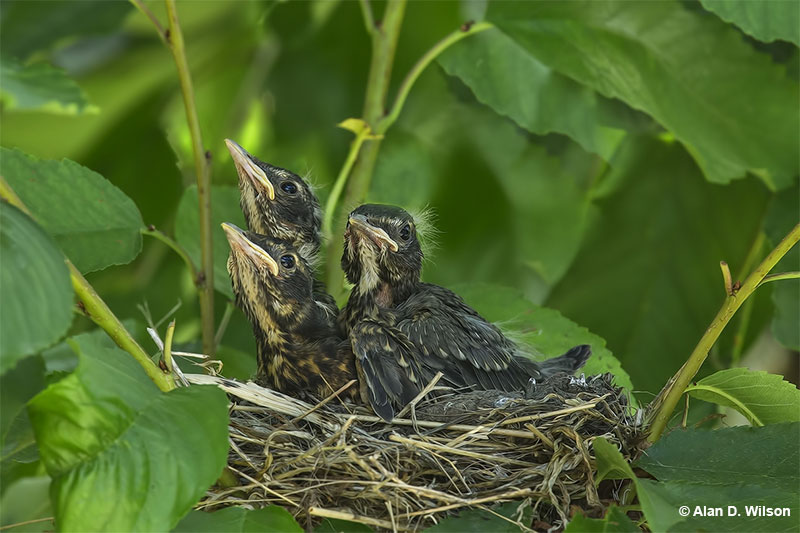
Baby robins are waiting for food!
Although many stay near their nesting areas, they can migrate to other states in search of food. During winter, flocking together gives them some protection from Cooper’s Hawks and other raptors that prey on them.
At other times of year, American Robins also have to avoid Raccoons, Domestic Cats, and many other small mammals and snakes that attack both nests and adults.
Other Birds In Connecticut
Did you know that Connecticut has over 400 different bird species? From hawks and owls to woodpeckers and ducks, there is a lot to see!
Here are some common species you can see:
- Northern Cardinals
- Blue Jays
- Black-capped Chickadees
- Song Sparrows
- American Robins
- Tufted Titmice
- Mourning Doves
See more – most common birds in Connecticut
Frequently Asked Questions
What is the state bird of Connecticut?
The state bird of Connecticut is the American Robin.
Why is the American Robin the state bird of Connecticut?
The American Robin is the state bird of Connecticut because it is a common, easily recognized, and much appreciated bird in the state.
When did Connecticut choose its state bird?
Connecticut chose its state bird in 1943.
What other states have the American Robin as their state bird?
Other states that have the American Robin as their state bird are Michigan and Wisconsin.
What is Connecticut’s state animal?
Connecticut’s state animal is the Sperm Whale.
What is the state flower of Connecticut?
The state flower of Connecticut is the Mountain Laurel.

